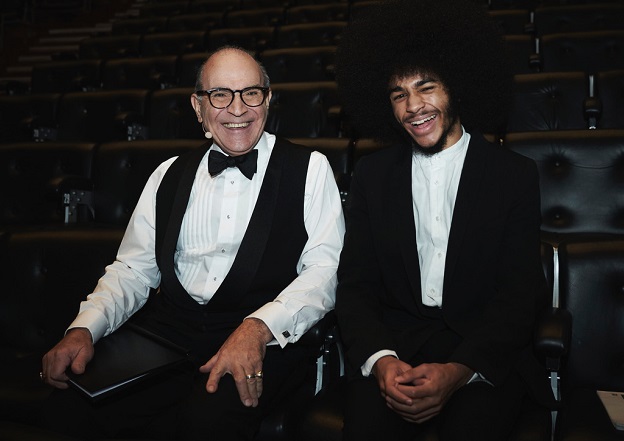
 United Kingdom Ravel and Gershwin: David Suchet (narrator), Sebastian Benedict-Flore (piano), Odyssey Festival Orchestra (leader: Leon Human) / Peter Ash (conductor). Queen Elizabeth Hall, London, 13.1.2023. (JC)
United Kingdom Ravel and Gershwin: David Suchet (narrator), Sebastian Benedict-Flore (piano), Odyssey Festival Orchestra (leader: Leon Human) / Peter Ash (conductor). Queen Elizabeth Hall, London, 13.1.2023. (JC)

Ravel – Valses nobles et sentimentales; La Valse
Gershwin – An American in Paris; Rhapsody in Blue
For their inaugural concert at the Queen Elizabeth Hall, the newly-formed Odyssey Festival Orchestra curated a brilliant programme which took us on a journey from nineteenth-century fin-de-siècle Paris to New York in the Roaring Twenties, simultaneously juxtaposing the views of the nostalgic and embittered Frenchman that is Maurice Ravel with that of the excited and curious American George Gershwin through the enthusiastic narration of actor David Suchet.
The Odyssey Festival Orchestra is an ensemble for gifted musicians — amateur or professional — aged between 18 and 30, the brainchild of conductor Peter Ash, who has years of experience leading youth projects in classical music. It was encouraging to see not only the stage, but also the seating, packed — and I mean packed — with young people; Odyssey welcomes collaborations with schools and local community groups, and on this occasion had invited students from numerous schools in London.
The first item on the programme, Ravel’s Valses nobles et sentimentales, was delivered in a ‘Peter and the Wolf’-style, aided by David Suchet’s lively narration. He gave the audience an overview of the work’s background as well as summarised the story of the ballet The Language of Flowers – to which this orchestral piece was originally set — alongside the performance. Sceptical at first about the efficacy of talking over music I was familiar with as standalone pieces, I was convinced and humoured by the impressions Suchet did of Ravel, and his ability to put on a French accent (a skill no doubt honed by his most famous role as Hercule Poirot on TV). Despite the clichéd nature and predictability of the story plot itself, Suchet’s acting fired up my imagination and gave the already well-loved piece new meaning. One nevertheless could feel the young musicians only just warming up, navigating the new performance parameters set up by this unfamiliar style of classical music performance. Coming from a group of talented and highly skilled musicians, the sound the orchestra made was rather tame in this first piece.
The second piece, Gershwin’s An American in Paris, was a lot more convincing in its performance. This time, Suchet provided the backdrop for the piece (in an American accent with a hint of Brooklyn) and left the orchestra to its devices. Peppered with solos and solis, this fun and groovy piece allowed the enthusiastic musicians to show off their own flair and have a good time. The orchestra was also very much together, making for a very entertaining performance.
Satisfied and gratified by ice cream and pints, the audience settled back down after the interval for the most well-known piece in the programme: Gershwin’s Rhapsody in Blue, delivered by pianist Sebastian Benedict-Flore. For me this was the highlight of the concert. Narration was also included to introduce the piece, although I sympathise with the pianist having to wait at the piano while the narrator talked. I mustn’t forget to give Nelson Sinclair-Strong his due credits for nailing the infamous (and slightly notorious) clarinet solo in the opening before going on to praise Sebastian. Sebastian was calm and controlled throughout the performance, coming in with precise timings, leading the orchestra rather than waiting for it to lead him, but it was his eagerness to make music that made a lasting impression of this young debutante. The raw energy of the live performance, enhanced by meticulous attention to rhythmic detail, brought out the groove in the music. Sebastian was a natural storyteller on stage at the keyboard, making us all listen intently, eager to hear what he had to say next. A rather surprising appearance in the performance was that of the banjo, which I never knew existed in the score. Positioned next to the cellos and thus closest to the microphone, it was perhaps slightly over-amplified, creating for unexpected comic effects, not unwelcome in such a fun piece as Rhapsody in Blue.
The concert ended with Ravel’s La Valse for orchestra, a grotesque parody of the classic Viennese waltz by a Frenchman looking on bitterly at the decadence all around him, so often misunderstood to be a showcase of virtuosity when taken out of context in concert halls nowadays. Once again, I was struck by the creativity of the programme, highlighting the different views of two composers who lived in the same era but looked at home and abroad very differently; as a programme it offered a wonderfully diverse and entertaining introduction to classical music for young people. However, in light of Suchet’s learned yet lively lecture preceding the performance, I was expecting a performance teetering on the edge with exaggerated swells in volumes which unfortunately was not delivered. Although everything was very much together and played correctly, it was perhaps too ‘decent’ for Ravel’s vision. Given the virtuosity and musicianship of the players as demonstrated in An American in Paris, I knew I could expect even more in the future from this orchestra.
Jeremy Chan
